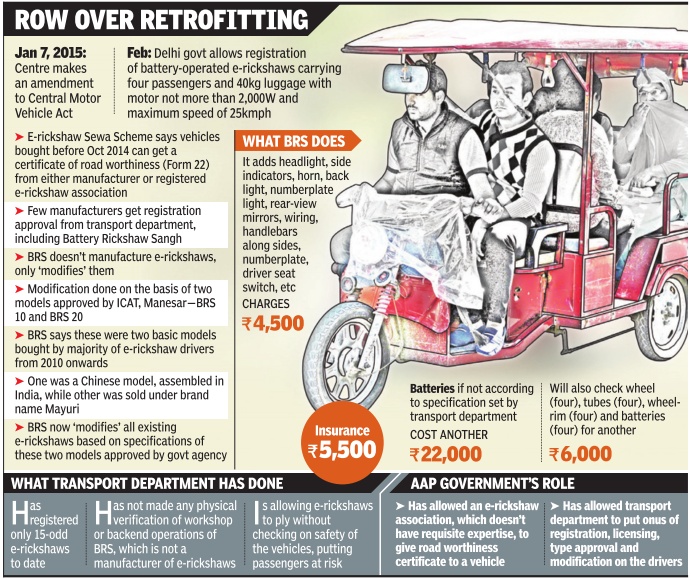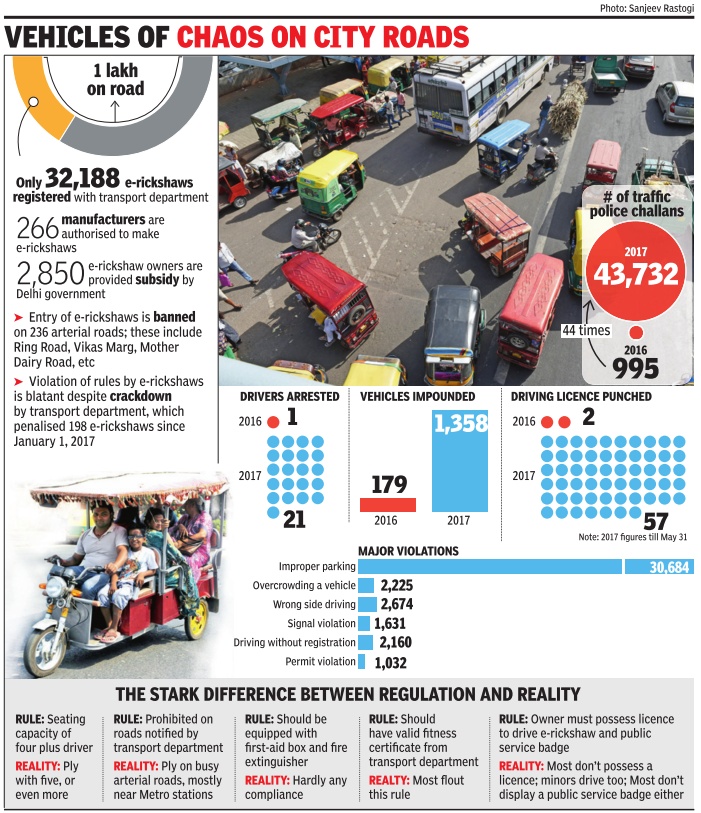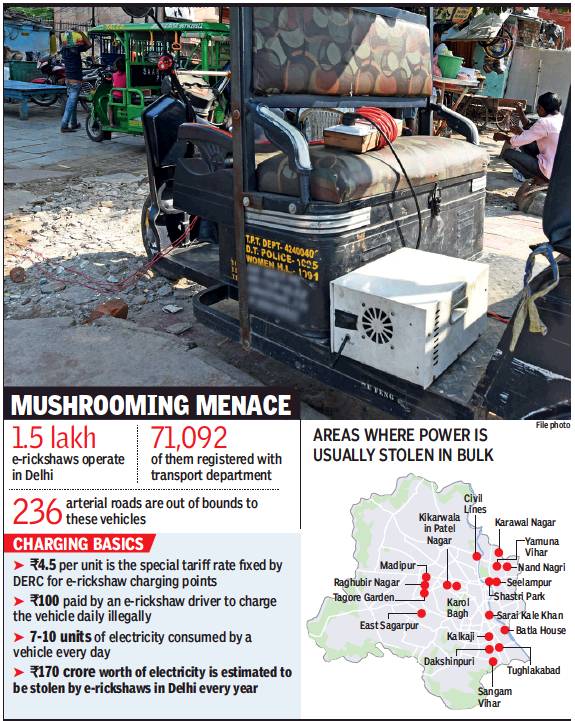Electric rickshaws: Delhi

This is a collection of articles archived for the excellence of their content. |
(Electric) E-rickshaws
2016-17: a major traffic hazard
Sidhartha Roy, Why e-ricks are biggest traffic hazards, June 10, 2017: The Times of India

Only A Third Of The Green Vehicles Plying On Delhi Roads Are Registered
The first e-rickshaws were seen around 2012 and have since ballooned in the past five years, mostly because of the last-mile connectivity they provide at pocket-friendly rates. The Delhi government's transport department doesn't have a record of the exact number of e-rickshaws operating in the city , but estimates that there are over a lakh such vehicles.
In 2014, following a central notification, the Delhi government had laid down operating guidelines. But these are rarely followed. A little more than 30,000 erickshaws are registered with the government. That means over 70% of such vehicles are unregulated.
Most e-rickshaws ply overloaded with passengers and goods and are often driven rashly , flouting all kinds of rules. Many have been involved in fatal accidents. For instance, in July 2014, a child died in Trilokpuri when it fell into boiling sugar syrup after being hit by an e-rickshaw. This incident had resulted in the Delhi high court intervening and ordering the vehicles off the road pending the promulgation of a regulatory mechanism.
Now, guidelines are in place but enforcement is a major problem. The government cites lack of manpower. “Of a total sanctioned strength of 810, we just have 183 in the enforcement wing,“ an official said on condition of anonymity . “There are also practical problems involved in impounding unregistered e-rickshaws. These are battery operated and cannot be made to travel long distances to the dumping yards. Also, we don't have enough space to park impounded e-rickshaws,“ he said. Transport department officials prefer to pass the buck to the traffic police.
But there are many who feel e-rickshaws are a necessary evil. Paharganj resident Ketan Manchanda (26) is among them. “An e-rickshaw ride is not a comfortable one.The drivers pack the vehicles with more than four passengers and these are so light that you can feel the e-rickshaw vibrate when a bigger vehicle passes by . Also, these are driven so rashly that there is always the danger of the vehicle toppling over at sharp turns,“ he said.
E-rickshaws have also seen a whole new industry grow around them. There are 266 registered e-rickshaw manufacturers. Most of the components, such as motors and controllers, are imported from China and assembled locally. “Earlier most of the parts were imported from China but now many parts are manufactured in India too,“ said Sunil Maggo who runs a dealership in Paharganj.
Then there are the spare parts shops and garages that let drivers charge a vehicle overnight for a nominal fee as low as Rs 100. There is a separate industry involving the resale of used batteries. But there is no policy for their safe disposal yet.
Menace: As in 2019
Sidhartha Roy, Sep 6, 2019: The Times of India

From: Sidhartha Roy, Sep 6, 2019: The Times of India
A man recently died of electrocution after he touched a gate near his house in northeast Delhi’s New Usmanpur. A police probe revealed that an illegal e-rickshaw charging point set up by a group of power thieves in the area had caused the accident. The miscreants had hooked a cable to an overheard power unit and wound the wire on the iron gate.
E-rickshaws, which have mushroomed in Delhi over the last few years, cause not only a traffic menace on the road but also pose a safety hazard when their batteries are illegally charged overnight. In the past few years, several cases of people getting electrocuted or injured due to illegal charging units have been witnessed. Three people were charred to death and more than a dozen people injured in Shahdara in November 2016 after a short circuit triggered a fire in a building where e-rickshaws were being charged.
Though the number of erickshaws has spiralled, the city lacks enough parking spaces, pick-up points and charging stations for them. The number of authorised charging points is almost negligible, which has resulted in a thriving industry of illegal charging points.
“Most e-rickshaws are charged in batches as part of an organised illegal network controlled by the local mafia. Owners pay Rs 100 to Rs 150 for full charging of the batteries, which takes between six and seven hours,” said a source. “Those running these illegal charging stations steal electricity from the main power lines,” the source added.
According to experts, power worth Rs 170 crore is stolen every year by e-rickshaws.
The cost of charging an erickshaw at the authorised points, however, comes to only about Rs 45 per 10 units. “This translates to about Rs 1,350 per month. But e-rickshaw owners still prefer to spend Rs 3,000 to Rs 4,500 per month at illegal charging points as there are not many authorised charging points in the city. Also, they can’t wait in queues for long and travel far to get their vehicles charged,” said an official source.
“The areas where largescale theft of power by erickshaws is taking place include Sangam Vihar, Batla House, Kalkaji, Tughlaqabad, Sarai Kale Khan and Dakshin Puri (south Delhi); Raghubir Nagar, Tagore Garden, East Sagarpur and Madipur (west Delhi); Seelampur, Yamuna Vihar, Shastri Park, Karawal Nagar, Mustafabad and Nand Nagri (east Delhi); Karol Bagh and Keekarwala (central Delhi); and Keshavpuram and Civil Lines (north Delhi),” the official added.
As per an estimate, the number of e-rickshaws would have easily crossed 1.5 lakh in Delhi. Only 71,092 e-rickshaws are, however, registered.